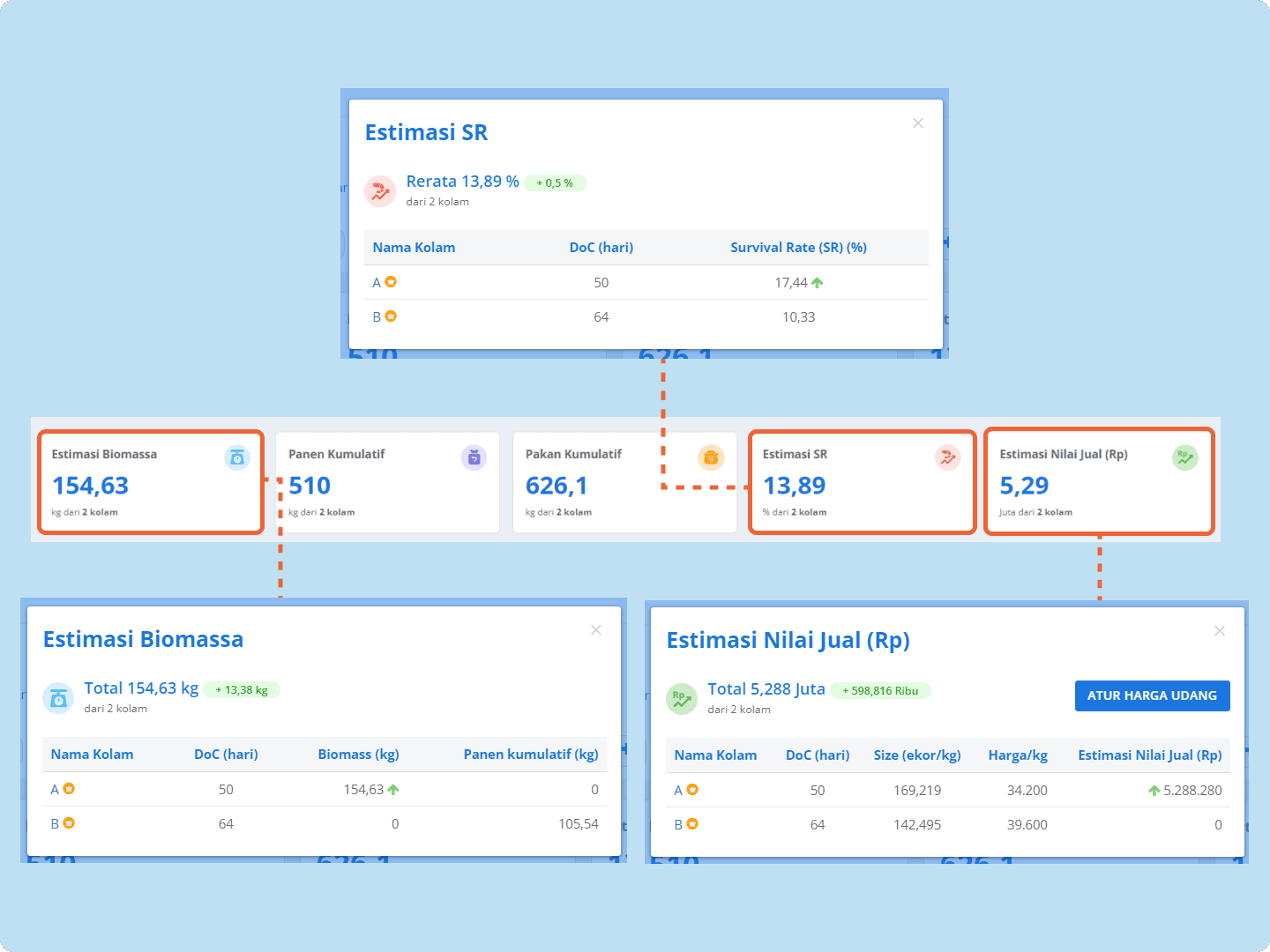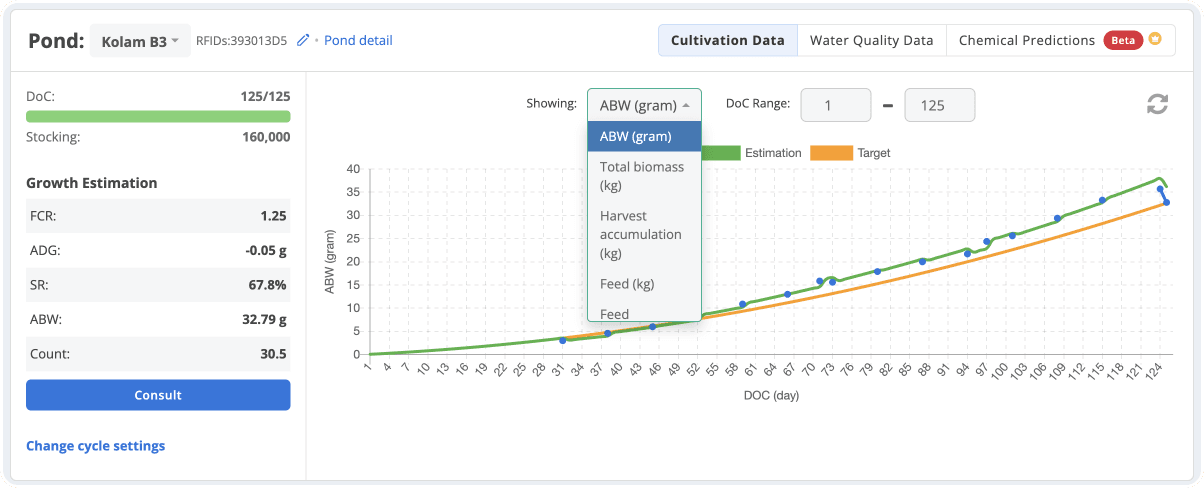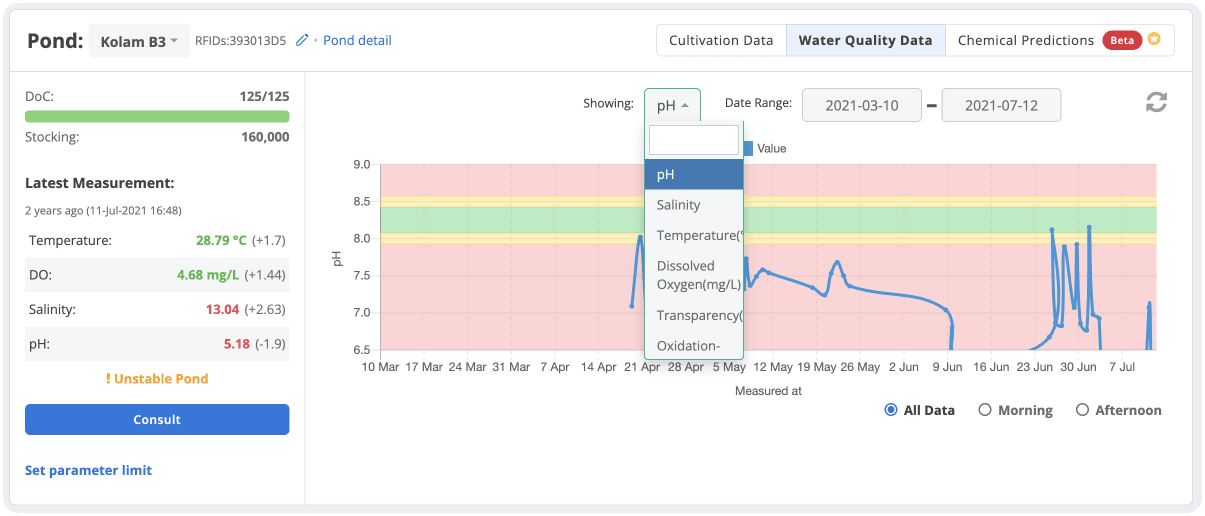
Conducting cultivation management with the right tools can improve effectiveness and efficiency. One of the ways to do this is using JALA App, a shrimp cultivation management application with various features to help you record and monitor water quality, cultivation productivity, and financial conditions in your farm.
JALA App comes with a comprehensive dashboard which makes it an essential tool for your cultivation management. Here are some important terms you can find on the JALA App homepage and their definitions in case you haven’t got to know them:
Biomass Estimation
Biomass estimation serves as a prediction of biomass or total shrimp mass in your farm. This estimate is displayed in kilograms (kg) and is accumulated from several ponds. To view detailed estimates from each pond, choose the Biomass Estimation card.

Biomass is defined as the total mass of the shrimp population in a certain period and is usually written in mass units (kilograms or tons). Shrimp biomass can be estimated by multiplying the survival rate (SR) with average shrimp body weight (ABW) in a certain period.
SR Estimation
Survival rate (SR) estimation shows the average SR calculation in your farm, obtained from several ponds in the farm. Survival rate or SR is the percentage of shrimp that lives in your farm at a certain period compared to the initial population during stocking.
Shrimp Value Estimation
Shrimp value estimation on JALA App’s dashboard is calculated from biomass estimation multiplied by the current shrimp price. Shrimp price is selected based on shrimp size estimation and is adjusted to the farm area or nearby location.
Cumulative Harvest
Harvesting is a process of collecting production yields from cultivation activities. In JALA App’s dashboard, the “Cumulative Harvest” card cumulatively records data from partial and total harvest in the farm.
Cumulative Feed
You can also find the “Cumulative Feed” card in the JALA App dashboard. It refers to the total or accumulated feed in the farm, calculated based on the total feed in each pond.
Day of culture (DoC)
Day of culture (DoC) refers to how long the cultivation has taken place, and is usually counted after stocking in days. On JALA App’s dashboard, once the pond has been stocked, DoC will automatically be counted as a reference of how long the cultivation runs.
DoC is also an important scale to evaluate various estimations given by JALA App towards cultivation conditions such as ABW, size, biomass, SR, and other estimations.
Cultivation Data
Cultivation data on JALA App’s dashboard summarizes various parameters related to the cultivation conditions in terms of productivity. It includes displaying growth estimates (FCR, ADG, SR, MBW, size), biomass, daily feed, COGS, potential income, and potential profit.

Select the "Cultivation Data" toggle on JALA App’s homepage to display various visualizations of your pond cultivation conditions.
Water Quality Data
Water quality data on JALA App dashboard’s summarizes various parameters related to pond water quality conditions. All water quality parameters, including physical, chemical, and biological parameters, are displayed with graphs.

Select the "Water Quality Data" toggle on JALA App's homepage to display various visualizations of your pond cultivation water quality conditions.
Chemical Prediction
Chemical predictions on JALA App’s dashboard summarize predictions for various chemical parameters of water quality. Predicted parameters include TOM, ammonia, nitrite, nitrate, bicarbonate, carbonate, alkalinity, magnesium, calcium, and hardness.

Select the "Chemical Predictions" toggle on JALA App’s homepage to display various visualizations of the chemical parameters of your pond.
Size
Size refers to shrimp size, and is obtained by counting the amount of shrimp in one kilogram. Size is shown in shrimp/kg.
Stocking
Stocking or stocking density is the ratio of shrimp fry (post larvae/PL) over pond area, and is shown in PL/m².
RFID
RFID or radio frequency identification is the pond identity card which is connected to the water quality measurement device, JALA Baruno. The RFID card is registered to each pond as a unique identifier when measuring water quality, so that the measured data will be assigned to the right pond.
Data is crucial when problems arise, and becomes more important to pursue cultivation success
The terms above are closely related to recording data and extracting information obtained from the compiled data. This compilation can be used to ensure that cultivation is on the right track, such as monitoring biomass estimates to shrimp value estimates. Technically, the graphs displayed in the water quality data section will provide an overview whether water conditions are ideal for shrimp or needs adjustment.
The presence of data becomes even more crucial if issues arise, such as slow shrimp growth or shrimp diseases. A farmer can have a foundation in identifying the root of the problems by examining the water quality history, including physical or chemical-biological parameters and daily feed provision.
These are some of the 10+ terms found in JALA App’s dashboard that are also related to cultivation. For further questions or a demonstration of app usage, please contact 0813-2551-4194.





